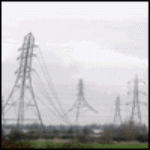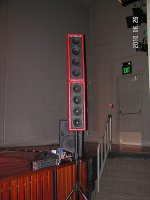I don't know algorithm of Audissey from Denon, but it works quite well!
How yours work?
I did an article on how to eliminate feedback from live sound systems 25 years ago. Bell Labs after that got a patent on the same process. They used a comb filter and pitch shifter. It sounds absolutely horrible, as it should as comb filters are used primarily as "Flangers."
I have since developed a better algorithm. What I realized is that instead of using Hilbert transforms by swapping the order of the other processes a pair of multiplies will do the same thing!
It is strange, because when I correct frequency response for concerts I always come to almost the same EQ cuts that reflect some speaker-specific resonances. And that frequencies don't look like comb filter. When enclosures of line arrays are well damped and free from ringings it is possible to make such a way flat frequency response so you can sing on 3 - 4 feet distance from large diaphragm condensers, in a hall of any size, from small room to theater.
When change of microphone position causes feedback that means something wrong had been equalized, like results of interference instead of speaker resonances. Of course reflections and interference cause uneven frequency response where microphone stands, but they should not be touched by EQ, because they are results of diffused field, that don't cause artificial colorations. What cause artificial colorations and has to be removed, boosts caused by speaker resonances. I suppose that designers of Audissey knew that well, that's why it sounds so good in home cinema theater, even with stock speakers from hi-fi store.
By the way, back to power supplies, conditioners and filters, here is the picture that shows what can cause such effects
When change of microphone position causes feedback that means something wrong had been equalized, like results of interference instead of speaker resonances. Of course reflections and interference cause uneven frequency response where microphone stands, but they should not be touched by EQ, because they are results of diffused field, that don't cause artificial colorations. What cause artificial colorations and has to be removed, boosts caused by speaker resonances. I suppose that designers of Audissey knew that well, that's why it sounds so good in home cinema theater, even with stock speakers from hi-fi store.
By the way, back to power supplies, conditioners and filters, here is the picture that shows what can cause such effects
Attachments
That must have been a very windy day! (With enough cloud charge to lift a pylon, too)
I'll bet you can't do double dutch.
That must have been a very windy day! (With enough cloud charge to lift a pylon, too)
True High-End should be weather-independent!
I'll bet you can't do double dutch.
I can
It is strange, because when I correct frequency response for concerts I always come to almost the same EQ cuts that reflect some speaker-specific resonances. And that frequencies don't look like comb filter. When enclosures of line arrays are well damped and free from ringings it is possible to make such a way flat frequency response so you can sing on 3 - 4 feet distance from large diaphragm condensers, in a hall of any size, from small room to theater.
When change of microphone position causes feedback that means something wrong had been equalized, like results of interference instead of speaker resonances. Of course reflections and interference cause uneven frequency response where microphone stands, but they should not be touched by EQ, because they are results of diffused field, that don't cause artificial colorations. What cause artificial colorations and has to be removed, boosts caused by speaker resonances. I suppose that designers of Audissey knew that well, that's why it sounds so good in home cinema theater, even with stock speakers from hi-fi store.
By the way, back to power supplies, conditioners and filters, here is the picture that shows what can cause such effects
When you say that you do concerts, are you using this system?
Attachments
When you say that you do concerts, are you using this system?
Yes. Of course, I do not mean rock bands.
That JBL on stage was not used then, it was in-house and could not be used for the concert: you know why -- directionality, frequency response... My pair of foldable line arrays with 2x80W tube amp covered the theater perfectly, for children concert (choir, ensemble, soloists...) -- there were five condenser microphones on stage that covered everything. They were dancing, singing, moving, average level was 75 dB.
Here you see the same speakers on open air: the same 3-4 feet from microphones. It was a bard festival, in the evening about 800 listeners assembled there.

Last edited:
Anatoliy
In other words. You don't have a clue about what you are talking about.
Then please explain what do you mean, to teach us a little bit to make the level of discussion a bit higher. I know very well what I am talking about, but unfortunately I can't show you the sound on concert through online forum. You have to be there to see and hear.
Edit: if you don't see correlation between distance from microphone on stage and equalization of frequency response of speakers, it is actually you who have no clue what we are talking about.
Last edited:
Well let me say something here, hopefully with the best intentions toward everyone.
First, Wavebourn, this is an awfully small PA system. OK for indoors, acceptable for picnics, but NOT a real concert, either folk, or R&R. That is reality. Too little power, too few speakers, etc. However, if it works for your gatherings, that is just fine.
As far as feedback is concerned, what kind of mikes are you using, directional or omni?
This is important when it comes to feedback, especially with outdoor playback. Look how forward your speakers are located. That would be impossible with a real rock or even a folk group with 100 people or more, attending. Still, I am sure that you do a good job, please just remember that some here do up to 500,000 people, and our methods are necessarily different.
First, Wavebourn, this is an awfully small PA system. OK for indoors, acceptable for picnics, but NOT a real concert, either folk, or R&R. That is reality. Too little power, too few speakers, etc. However, if it works for your gatherings, that is just fine.
As far as feedback is concerned, what kind of mikes are you using, directional or omni?
This is important when it comes to feedback, especially with outdoor playback. Look how forward your speakers are located. That would be impossible with a real rock or even a folk group with 100 people or more, attending. Still, I am sure that you do a good job, please just remember that some here do up to 500,000 people, and our methods are necessarily different.
Well let me say something here, hopefully with the best intentions toward everyone.
First, Wavebourn, this is an awfully small PA system. OK for indoors, acceptable for picnics, but NOT a real concert, either folk, or R&R. That is reality. Too little power, too few speakers, etc. However, if it works for your gatherings, that is just fine.
As far as feedback is concerned, what kind of mikes are you using, directional or omni?
This is important when it comes to feedback, especially with outdoor playback. Look how forward your speakers are located. That would be impossible with a real rock or even a folk group with 100 people or more, attending. Still, I am sure that you do a good job, please just remember that some here do up to 500,000 people, and our methods are necessarily different.
Of course, it is totally different story, concerts for 500 and 500,000 listeners. And of course size of the auditory matters worsening the situation causing additional problems, but the principle is still the same: the flatter is frequency response, the higher sensitivity of microphones is allowed. The farther is the singer from microphone, the flatter that means is frequency response of speakers.
When I worked with rock band, I was more concerned of frequency response of on-stage monitors, in terms of feedback. It worked the same way. But I did not need such sensitivity then, because anyway instrument cabs and drums were quite loud on stage.
And, let me repeat, equalizing frequency response no matter in theater, in the room for home concert, on open air, I am getting almost the same cuts on equalizers, on almost the same frequencies that correspond to boosts of speakers. And they don't look like a comb filter, that's why I said that it sounds strange to me what Ed said about comb filter. I expected him to explain, instead of Stein to measure sizes.
What's the cutoff attendance for a concert being "real"?
It can be a single person. The condition in this particular case is, at least one speaker and at least one microphone.
That's pretty much how I see it. Performer, audience. If it takes 20,000 people before a concert is "real," then I confess I haven't been to a concert in over 30 years.
I'm not sure anyone with >20,000 fans is worth the bother.
I'm not sure anyone with >20,000 fans is worth the bother.
I think the last big concert I saw was the Grateful Dead at Alpine Valley.
But Hillary Hahn At Mondavi recently was pretty good and I remember it too. No mics no amps.
I'm not sure anyone with >20,000 fans is worth the bother.
Precisely.
Like wayne, I think the Dead was the last "big" show I saw. That would have been 1994, so OK, it's been 17-18 years, not 30. Ooops. Not sure of the attendance figures.
edit: The area seated about 15,000, so maybe it didn't qualify as "real." That's my problem, not enough "real" concerts.
- Status
- Not open for further replies.
- Home
- Member Areas
- The Lounge
- John Curl's Blowtorch preamplifier part II


 Stein, warning!
Stein, warning!